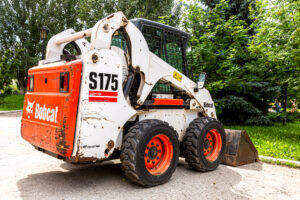If you have leaking Bobcat auxiliary hydraulic couplers, you may be wondering the best way to remedy this situation safely and with the least amount of expense as possible. We can help to answer both of those concerns with tips for what not to do when your skid steer coupler starts showing signs of leaking and how you can replace your Bobcat couplers without spending a fortune on brand-name quick couplers.
Safety First When Dealing with Hydraulic Coupler Leaks
When it comes to separating myth from fact on how to handle hydraulic fitting leaks, it can be somewhat confusing knowing what to believe and who to listen to. Here are some tips from hydraulic quick connect experts who have seen it all and have been in the industry for decades. One thing to always remember is that hydraulic fluid leaks, especially when pressurized, can pose serious safety concerns, and this should be your first priority.
Here’s What Not to do for Auxiliary Hydraulic Coupler Leaks:
In order to cover what you should do for leaking auxiliary hydraulic quick couplers, let’s first review what you absolutely should NOT do in the case of hydraulic quick connect leaks. Before you start grabbing your leaking coupler to get a closer look, read the following tips to make sure that you don’t get burned, literally.
1) Do not check for leaks with your hands – hydraulic fluid can reach high temps in the range of 300°F or more, which will cause serious burns if it comes in contact with your skin. Even with gloves on, a pinhole leak with high velocity can exert in excess of 600 feet per second, which may inject hydraulic fluid right through thick leather gloves and into your skin. This has been known to occur even with only 100 psi of pressure and up to four inches away from the fluid source. If exposed to hydraulic fluid in high temps or if penetration of the skin occurs, seek immediate medical attention as the results could be devastating, even requiring possible amputation.
2) Do not just over-tighten – Occasionally, a loose nut may be the culprit of a fluid leak, although all too often, we see people over-tighten the nut, thinking the tighter, the better. This only ruins the integrity of the fitting and is one of the most common causes of hydraulic fitting leaks. Be sure to examine the fitting connection before over-torquing the fitting instinctively.
3) Do not forget to depressurize the system – Never leave a system pressurized when inspecting the connections, even if you only see a small drip of fluid on the ground. When releasing pressure before disconnecting Bobcat auxiliary hydraulic couplers, most Bobcats will have a pressure disconnect that releases pressure if you push in on it before disconnecting. There may be two of these, on the top and bottom, be sure to press in on both of them to release pressure before disconnection.
4) Do not re-use O-rings – Even if you decide to reassemble a fitting (we recommend replacing the fitting altogether), you should never re-use an O-ring. O-rings are susceptible to cracking which may ruin the integrity of the seal when reassembled. Stucchi offers an instructional video on How to Replace the Seals on a Flat Face Coupler, which should only be performed on the male coupler, not the female coupler, as it is more complex.
Video – How to Replace the Seals on a Flat Face Coupler
5) Do not just assume it’s the fitting that’s leaking – The leak point may be different from the drip point as drips occur at the lowest point of gravity. Just because fluid is dripping off from the coupler doesn’t mean the actual leak is from that connection.
6) Don’t forget about flammability – People sometimes forget that even a pinhole leak may create a mist-like cloud of flammable vapor. Be sure to keep any source of flame, including cigarettes, lighters, and cutting or welding torches, far away from any hydraulic fluid leak.
7) Do not ignore a hydraulic leak – a minor leak may be a sign of a more serious problem with the hydraulic system and could lead to inefficiencies and poor performance. Contact a hydraulic quick coupler expert like Stucchi with any questions on diagnosing or replacing leaking quick couplers.
Replacing Bobcat Auxiliary Hydraulic Coupler
Anytime you do experience a leak with your Bobcat auxiliary hydraulic couplers, it is best to replace the coupler rather than attempt to rebuild it. Stucchi offers quick couplers compatible with brand names such as Bobcat, Caterpillar, John Deere, Kubota, and other skid steer couplers, which provide proven long-lasting performance. Check out our video section for several helpful, instructional videos, including How to Upgrade Your Bobcat 870 Skid Steer Auxiliary Hydraulics to High Flow.
Video – Upgrade Your Bobcat 870 Skid Steer to Handle High Flow
We provide customized hydraulic solutions, such as this Bobcat Bracket Conversion, that features our VEP threaded, flat-face series for heavy-duty, long-lasting performance.
Stucchi is recognized for delivering a constant flow of hydraulic solutions custom designed to meet your specific requirements. Learn more about replacing Bobcat quick couplers and realize the benefits of quick connect systems designed by Stucchi. We provide auxiliary hydraulic kits to convert standard couplers to Stucchi’s heavy-duty couplers that support high-flow hydraulics or all brand-name equipment.
Stucchi is a leading global supplier of hydraulic quick couplers, offering high-quality products and custom-designed solutions. We offer process analysis and development to maximize productivity, efficiency, and safety. Contact us to learn more about replacing couplers with safety and affordability, including Bobcat auxiliary hydraulic couplers.





